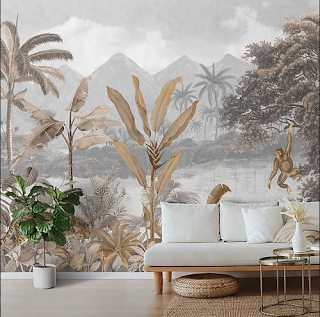European wallpapers are one of the most trending and tasteful parts of inside design. The most recent couple of decades have seen a huge expansion in deals and interest for them. In any case, stand by, at any point wondered how they're made? What is it about wallpapers that make them dazzle your bedroom wall? While there are several elements that aid in the assembling of wallpapers, printing wallpaper designs is perhaps the main one.
Since the time antiquated times, printing has taken many forms. The equivalent goes for wallpapers as well. Wallpapers were at first printed through procedures, for example, hand painting, wood impeding, and stenciling to upgrade one's home decor. On account of modern innovation, be that as it may, there are many sorts of inks and methods organizations can utilize today.
A portion of these include; Eco-Solvent, UV, and Latex printing. Today we'll be investigating every one of the three and conclude which one of them is the most ideal decision.
What is Eco-Solvent printing?
To lay it out plainly, Eco-Solvent print is an inkjet print. Traditionally, wallpaper prints are not damaging to the climate however these are explicitly manufactured to such an extent that they generally do not produce any environmental waste or mischief the biological system. In spite of the fact that it actually contrarily affects the climate.
At the point when we investigate the nature of these wallpapers, they are made by eco-dissolvable ink which is formulated by colors suspended in a light biodegradable dissolvable.
This is the reason eco-dissolvable prints produce mediocre picture goal and are additionally not as well , they are very famous economically yet no such a great amount for wallpaper for kids rooms yet for showcasing material. You'll frequently find them in shops or shopping centers as informational or correspondence pennants. Due to poisonous nature of compound ink they are not recommended for wallpapers in homes or workplaces.
Eco-dissolvable offers incredible results due to their exact performance in printers. As a rule, their printers can create super fine dots of around 5-8 picoliters. Moreover, they're very hearty both indoors and outdoors, they are likewise impervious to water for a decent period as well.
What is UV Printing?
UV printing or Ultraviolet Light printing is a distinct and remarkable method of digital printing. The remarkable ink of the UV printing gets distributed and dries when applied to the printing medium immediately. In addition, it additionally keeps the ink from sinking into materials.
With regards to the traditional printing method, there are extraordinary solvents in the ink. When applied to a material or at the hour of printing, these solvents vanish in the air. These solvents then, at that point, discharge Volatile Organic Compounds or VOCs which are poisonous and are unsafe to the climate.
This course of dissipation of the solvents makes it more straightforward for the ink to get absorbed in the material. The vanishing of the solvents, as well as the drying of the ink additionally called relieving, will bring about the creation of the digital picture. Further, the traditional method uses and produces hotness and deliveries toxic odors.
While in UV printing the ink isn't composed of any solvents that vanish high up. LED lights are used for the most common way of relieving as opposed to utilizing heat. The UV ink contains a few Monomers, Pigments, and Photo-initiators. The ink dries immediately through polymerization, this is the point at which the photograph initiators get exposed to the UV light.
Additionally, in UV printing there is no arrival of any Volatile Organic Compounds or VOCs up high. There are likewise no toxic odors and the ink is water-safe too. Anyway UV ink might have chances of print breaking throughout some stretch of time.
